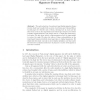Free Online Productivity Tools
i2Speak
i2Symbol
i2OCR
iTex2Img
iWeb2Print
iWeb2Shot
i2Type
iPdf2Split
iPdf2Merge
i2Bopomofo
i2Arabic
i2Style
i2Image
i2PDF
iLatex2Rtf
Sci2ools
ITRUST
2005
Springer
2005
Springer
Security and Trust in the Italian Legal Digital Signature Framework
Abstract. The early adoption of a national, legal digital signature framework in Italy has brought forth a series of problems and vulnerabilities. In this paper we describe each of them, showing how in each case the issue does not lie in the algorithms and technologies adopted, but either in faulty implementations, bad design choices, or legal and methodological issues. We also show which countermeasures would be appropriate to reduce the risks. We show the reflex of these vulnerabilities on the trust-based framework which gives legal value to digital signatures. We think that this study can help to avoid similar mistakes, now that under EU directives a similar architecture is planned or under development in most EU countries.
| Added | 28 Jun 2010 |
| Updated | 28 Jun 2010 |
| Type | Conference |
| Year | 2005 |
| Where | ITRUST |
| Authors | Stefano Zanero |
Comments (0)

